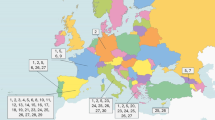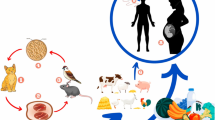Abstract
The aim of this study was to evaluate the seroprevalence of Paracoccidioides brasiliensis infection in wild New World monkeys (Cebus sp. and Alouatta caraya). A total of 93 animals (Cebus sp., n = 68 and Alouatta caraya, n = 25) were captured in the Paraná River basin, Paraná State, Brazil and the serum samples were analyzed by ELISA and immunodiffusion using P. brasiliensis gp43 and exoantigen as antigens, respectively. The seropositivity observed by ELISA was 44.1% and 60% for Cebus sp. and A. caraya, respectively, while by immunodiffusion test Cebus sp. showed positivity of 2.9% only. No significant difference was observed in relation to age and sex. This is the first report of paracoccidioidomycosis in wild capuchin monkeys and in wild-black and golden-howler monkeys. The high positivity to P. brasiliensis infection in both species evaluated in our study and the positivity by immunodiffusion test in Cebus sp. suggest that natural disease may be occurring in wild monkeys living in paracoccidioidomycosis endemic areas.
Similar content being viewed by others
References
Lutz A. Uma micose pseudo-coccidica localizada na boca e observada no Brasil: contribuição ao conhecimento das hypho-blastomycoses americanas. Bras Med 1908;22:141–4.
Coutinho ZF, Silva D, Lazéra M, Petri V, Oliveira RMO, Saborza PC, Wanke B. Paracoccidioidomycosis mortality in Brazil (1980–1995). Cad Saúde Pública 2002;18:1441–54.
Brummer SO, Castaneda E, Restrepo A. Paracoccidioidomycosis: an update. Clin Microbiol Rev 1993;6:89–117.
Blotta MHSL, Camargo ZP. Immunological response to cell-free antigens of Paracoccidioides brasiliensis: relationship with clinical forms of Paracoccidioidomycosis. J Clin Microbiol 1993;31:671–6.
Franco M. Host-parasite relationships in paracoccidioidomycosis. J Med Vet Mycol 1986;25:5–18.
Mós EN, Fava Netto C. Contribuição ao estudo da paracoccidiodomicose. I. Possível papel epidemiológico dos cães. Estudo sorológico e anatomo-patológico. Rev Inst Med trop S Paulo 1974;16:154–9.
Ono MA, Bracarense APFRL, Morais HAS, et al. Canine paracoccidioidomycosis: a seroepidemiologic study. Med Mycol 2001;39:277–82.
Conti-Diaz IA, Alvarez BJ, Gezuele E, Marini HG, Duarte J, Falcón J. Encuesta mediante intradermoreactiones con paracoccidioidina y histoplasmina en caballo. Rev Inst Med trop S Paulo 1972;14:372–6.
Gutierrez AH, Ceballos GC, Ferrer HIP, et al. Encuesta sobre tuberculosis, histoplasmosis y paracoddioidomycosis en ganado lechero del valle del Aburra. Antioquia Med 1974;24:339–58.
Costa EO, Diniz LSM, Fava-Netto C, et al. Delayed hupersensitive test with paracoccidioidin in captive Latin American wild animals. J Med Vet Mycol 1995;33:39–42.
Naiff RD, Ferreira LCL, Barret TV, et al. Enzootic paracoccidioidomycosis in armadillos (Dasypus novemcinctus) in the State of Para. Rev Inst Med trop S Paulo 1986;28:19–27.
Bagagli E, Sano A, Coelho KL, et al. Isolation of Paracoccidioides brasiliensis from armadillos (Dasypus novemcinctus) captured in an endemic area of paracoccidioidomycosis. Am J Trop Med Hyg 1998;58:505–12.
Silva-Vergara ML, Martinez R, Camargo ZP, et al. Isolation of Paracoccidioides brasiliensis from armadillos (Dasypus novemcinctus) in an area where the fungus was recently isolated from soil. Med Mycol 2000;38:193–9.
Corredor GG, Castaño JH, Peralta LA, et al. Isolation of Paracoccidioides brasiliensis from the nine-banded armadillo Dasypus novemcinctus, in an endemic area for paracoccidioidomycosis in Colombia. Rev Iberoam Micol 1999;16:216–20.
Ricci G, Mota FT, Wakamatsu A, et al. Canine paracoccidioidomycosis. Med Mycol 2004;42:379–83.
Bosco SMG, Theodoro RC, Macoris SAG, Farias MR, Muro M, Ribeiro MG, Bagagli E. Morphological and molecular characterization of the first isolate of Paracoccidioides brasiliensis from dog (Canis familiaris). Rev Inst Med trop S Paulo 2005;47 suppl 14:62–63.
Camargo ZP, Unterkircher C, Campoy SP, Travassos LR. Production of Paracoccidioides brasiliensis exoantigens for immunodiffusion test. J Clin Microbiol 1988;26:2147–51.
Puccia R, Travassos LR. 43-kilodalton glycoprotein from Paracoccidioides brasiliensis: immunochemical reactions with sera from patients with paracoccidioidomycosis, histoplasmosis and Jorge Lobo’s disease. J Clin Microbiol 1991;29:2610–5.
Bradford MM. A rapid and sensitive method for the quantitation of microgram quantities of protein utilizing the principle of protein-dye binding. Anal Biochem 1976;72:248–54.
Silveira LH, Domingos IH, Kouchi K, Itano EN, Silva EA, Landgraf VO, Werneck SM, Camargo ZP, Ono MA. Serological detection of antibodies against Paracoccidioides brasiliensis in dogs with leishmaniasis. Mycopathologia 2006;162:325–29.
Costa EO, Diniz LSM, Fava Neto C, Arruda C, Dagli MLZ. “Paracoccidioidomycosis-infection” survey in Brazilian captive primates (Cebus apella). Braz J Vet Res Anim Sci 1992;29:39–44.
Costa EO, Diniz LSM, Fava Netto C. The prevalence of positive intradermal reactions to paraccodioidin in domestic and wild animals in São Paulo, Brazil. Vet Res Comm 1995;19:127–30.
Bicca-Marques JC, Calegaro-Marques C. A case of geophagy in the black howling monkey Alouatta caraya. Neotrop Primates 1994;2:7–9.
Albornoz MB. Isolation of Paracoccidioides brasiliensis from rural soil in Venezuela. Sabouraudia 1971;2:248–51.
Johnson WD, Lang CM. Paracoccidioidomycosis (South American blastomycosis) in a squirrel monkey (Saimiri sciureus). Vet Pathol 1977;14:368–71.
Acknowledgments
The authors thank CNPq, CAPES and the Araucaria Foundation for financial support and IBAMA for the license to capture the animals.
Author information
Authors and Affiliations
Corresponding author
Rights and permissions
About this article
Cite this article
Corte, A.C., Svoboda, W.K., Navarro, I.T. et al. Paracoccidioidomycosis in wild monkeys from Paraná State, Brazil. Mycopathologia 164, 225–228 (2007). https://doi.org/10.1007/s11046-007-9059-y
Received:
Accepted:
Published:
Issue Date:
DOI: https://doi.org/10.1007/s11046-007-9059-y




